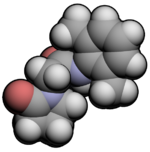 | |
 | |
| Clinical data | |
|---|---|
| Routes of administration | Oral |
| ATC code |
|
| Legal status | |
| Legal status |
|
| Pharmacokinetic data | |
| Elimination half-life | 3-5 hours[1] |
| Identifiers | |
| |
| CAS Number | |
| PubChem CID | |
| ChemSpider | |
| UNII | |
| ChEMBL | |
| CompTox Dashboard (EPA) | |
| ECHA InfoCard | 100.163.910 |
| Chemical and physical data | |
| Formula | C14H18N2O2 |
| Molar mass | 246.310 g·mol−1 |
| 3D model (JSmol) | |
| |
| |
| | |
Nefiracetam is a nootropic drug of the racetam family. Preliminary research suggests that it may possess certain antidementia properties in rats.[2]
- ^ Fujimaki Y, Sudo K, Hakusui H, Tachizawa H, Murasaki M (September 1992). "Single- and multiple-dose pharmacokinetics of nefiracetam, a new nootropic agent, in healthy volunteers". The Journal of Pharmacy and Pharmacology. 44 (9): 750–754. doi:10.1111/j.2042-7158.1992.tb05513.x. PMID 1360528. S2CID 25913554.
- ^ Murphy KJ, Foley AG, O'connell AW, Regan CM (January 2006). "Chronic exposure of rats to cognition enhancing drugs produces a neuroplastic response identical to that obtained by complex environment rearing". Neuropsychopharmacology. 31 (1): 90–100. doi:10.1038/sj.npp.1300810. PMID 15988469.